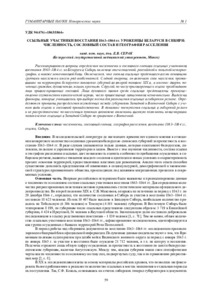Please use this identifier to cite or link to this item:
https://elib.psu.by/handle/123456789/21673| Title: | Ссыльные участники восстания 1863–1864 гг. уроженцы Беларуси в Сибири: численность, сословный состав и география расселения |
| Authors: | Серак, Е. В. |
| Issue Date: | 2018 |
| Publisher: | Полоцкий государственный университет |
| Citation: | Вестник Полоцкого государственного университета. Серия A, Гуманитарные науки. - 2018. - № 1 – C. 59-66. |
| Abstract: | Рассматриваются вопросы определения численности и сословного состава ссыльных участников восстания 1863–1864 гг. из Беларуси в Сибирь на основе отечественной, российской и польской историографии, а также источниковой базы. Отмечается, что состав ссыльных представлен всеми основными группами населения и имеет ряд особенностей. С одной стороны, он включает слои населения, проживавшие на территории белорусско-литовских губерний во второй половине ХІХ в., а именно: дворян, почетных граждан, духовенство, мещан, крестьян. С другой, по числу приговоренных к ссылке преобладают лица привилегированных сословий. Лица духовного звания среди ссыльных представлены преимущественно служителями католической церкви, число православных священников незначительно. Выделены факторы, которые учитывались при выборе места для размещения ссыльных в сибирском регионе. Определяются принципы распределения осужденных между губерниями Западной и Восточной Сибири с учетом вида ссылки и сословной принадлежности. В динамике поступления ссыльных в сибирский регион и их рассредоточение по населенным пунктам возможно отметить высокую плотность концентрации политических ссыльных в Западной Сибири по сравнению с Восточной.= The issues of determining the number and class composition of the exiled participants of the uprising in 1863-1864 are considered on the basis of native, Russian and Polish historiography, as well as a source base. It is noted that the structure of the exiles is represented by all major groups of the population and has a number of features. On the one hand, it includes groups of the population that lived in the territory of the Belarusian-Lithu-anian provinces in the second half of the nineteenth century, exactly noblemen, freemen, clergy, bourgeois and peasants. On the other hand, privileged classes dominate in the number of people who were sentenced to exile. The servants of the Catholic Church mainly represent people of the spiritual rank among the exiles, the number of Orthodox priests is insignificant. There were identified a number of factors that were taken into account when choosing a location for the exiles in the Siberian region. The principles of convicts’ distribution between the prov-inces of Western and Eastern Siberia are determined taking into account the exiles’ type and class membership. In addition, it is possible to note high concentration of political exiles in Western Siberia in comparison with the Eastern one. |
| Keywords: | Государственный рубрикатор НТИ - ВИНИТИ::ОБЩЕСТВЕННЫЕ НАУКИ::История. Исторические науки Численность Сословный состав География расселения Восстание 1863–1864 гг. Ссылка Сибирь Population Class structure Settlement geography Uprising 1863–1864 exile Siberia |
| URI: | https://elib.psu.by/handle/123456789/21673 |
| metadata.dc.rights: | open access |
| Appears in Collections: | 2018, № 1 |
Items in DSpace are protected by copyright, with all rights reserved, unless otherwise indicated.
